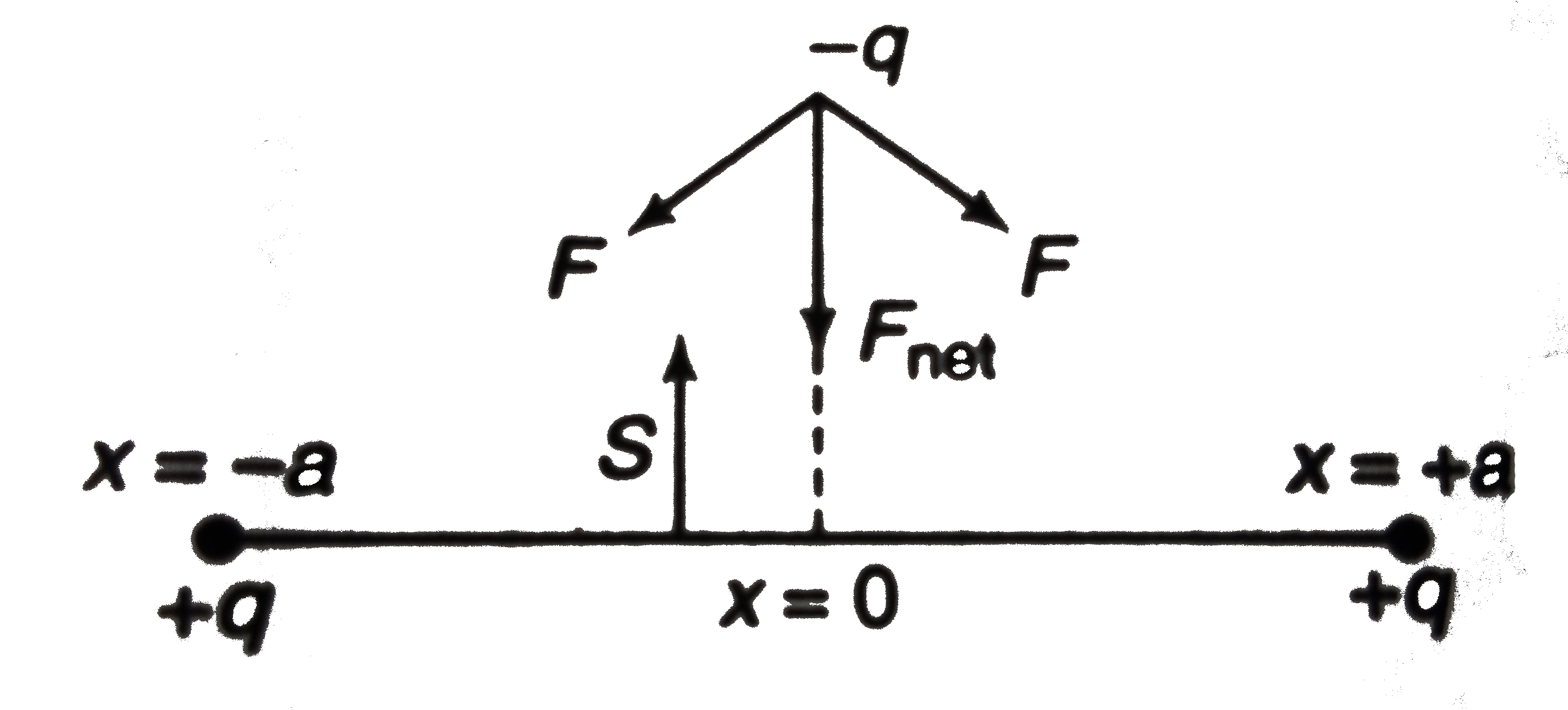Two point charges +q and fixed at (a,0,0) and (−a,0,0). A third point charge −q is at origin. State whether ite equlilbrium is stable, unstable or neutral if it is slightly displaced:
(a) along x-axis. , (b) along y-axis.
The correct Answer is:A, B
(a) At x=0,F=0. At P,
attraction on-q or
F1>attractionF2
 .
.
∴ Net force is in the direction of displacement.
So, equilirium is unstable.
(b) Fnet is in opposition of S. Therefore equilibrum is stable.
 .
.
Topper's Solved these Questions
- WORK, ENERGY & POWERBook:DC PANDEYChapter:WORK, ENERGY & POWERExercise:Exercise 9.5
Explore 2 Videos
- WORK, ENERGY & POWERBook:DC PANDEYChapter:WORK, ENERGY & POWERExercise:Introductory
Explore 1 Video
- WORK, ENERGY & POWERBook:DC PANDEYChapter:WORK, ENERGY & POWERExercise:Exercise 9.3
Explore 2 Videos
- WAVE MOTIONBook:DC PANDEYChapter:WAVE MOTIONExercise:Integer Type Question
Explore 11 Videos
- WORK, ENERGY AND POWERBook:DC PANDEYChapter:WORK, ENERGY AND POWERExercise:MEDICAL ENTRACES GALLERY
Explore 33 Videos
Similar Questions
Two equal positive point charges 'Q' are fixed at points B (a, 0) and A(-a, 0). Another test charge q0 is also placed at O (0, 0). Show that the equilibrium at 'O' is
(i) Stable for displacement along X-axis
(ii) Unstable for displacement along Y-axis.
View SolutionTwo point charge (Q each) are placed at (0,y) and (0,-y). A point charge q of the same polarity can move along X-axis. Then :
View Solution
Knowledge Check
Two point charges q each are fixed at (a,0) and (-a,0). A third charge Q is placed at origin. Electrons potential energy of the system will
Aincrease if Q is slightly displaced along x-axisBdecrease if Q is slightly displaced along x-axisCincrease if Q is slightly displaced along y-axisDdecrease if Q is slightly displaced along y-axisTwo point charges+q nd -q are held fixed at (−a,0) and (a,0) respectively of a x-y coordinate system then
Athe electric field E at all point on the axis has the same direction.BE at all points on the y-axis is along ˆiCpositive work is done in bringing a test charge from infinity to the originDAll of the aboveTwo point charges (Q each are placed at (0,y) and (0-y) A point charge q of the sme polarity can move along the x-axis. Then
Athe force on q is maximum at x=±y/√2Bthe charge q is in equilibrium at the originCthe charge q performs an oscillatory motion about the originDfor any position of q other than origin the force is directed away from origin
Two equal point charges are fixed at x=−a and x=+a on the x-axis. Another point charge Q is placed at the origin. The change in the electrical potential energy of Q, when it is displaced by a small distance x along the x-axis, is approximately proportional to
View SolutionTwo point charges +q and −q are held fixed at (−d,o) and (d,0) respectively of a x-y coordinate system. Then
View SolutionTwo equal positive charges Q are fixed at points (a, 0) and (−a,0) on the x-axis. An opposite charge -q at rest is relased from point (0, a) on the y-axis. The charge -q will
View SolutionTwo small particles P and Q each of mass m are fixed along x-axis at points (a,0) and (-a,0). A third particle R is kept at origin. Then
View SolutionTwo points +ve charges q each are placed at (-a, 0) and (a,0), A third +ve charge q0 is placed at (0, y). Find the value of y for which the force at q0 is maximum.
View Solution

